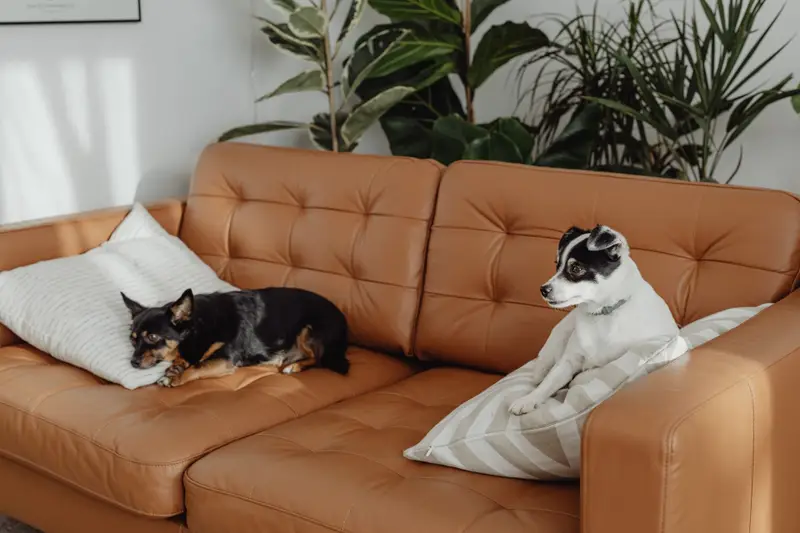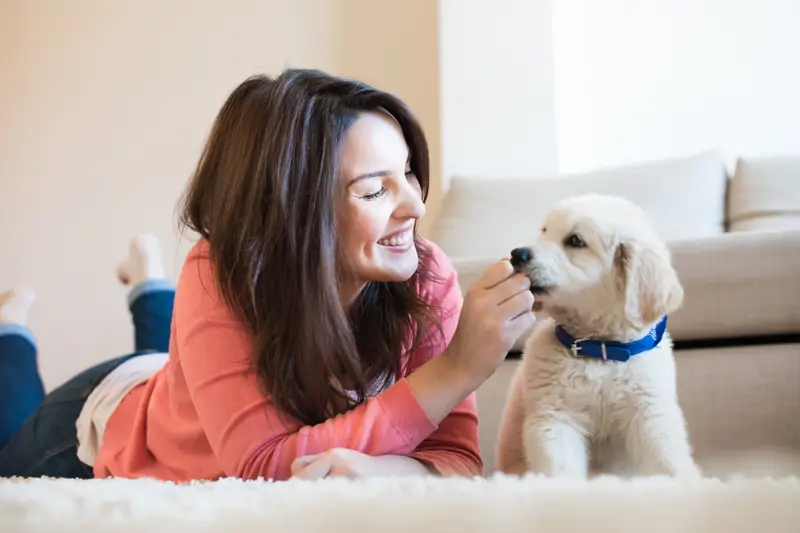A pet sitter home tour should cover where pet supplies are stored, daily routine locations, emergency contacts, and house-specific quirks like sticky doors or temperamental locks. The goal is functional clarity—show them what they need to do their job, not a complete home inspection.
You’re about to leave a stranger alone in your house with your pet. This walkthrough determines whether they can handle everything confidently or whether you’ll get texts at midnight asking where you keep the paper towels.
This isn’t about impressing them with your organizational skills. It’s about showing them exactly what they need, where to find it, and how to handle the inevitable weird situation that comes up. Your house has quirks. Your pet has quirks. Address both now or deal with confused messages later.
Before the Tour: What to Prepare
Don’t wing the home tour. Prepare in advance so you don’t forget critical information while showing the sitter around.
Create a Written Guide
Even if you do a thorough verbal walkthrough, leave written instructions. Sitters can’t remember everything from one conversation, especially if they’re managing multiple clients.
What to include:
- Pet feeding schedule and portions
- Medication instructions with dosage and timing
- Emergency contacts (you, backup person, vet, 24-hour clinic)
- House-specific instructions (security codes, thermostat, garbage day)
- WiFi password
- Anything unusual about your home or pet
For detailed guidance on writing effective instructions, read our article on how to leave detailed instructions for a pet sitter.
Gather Supplies in Accessible Locations
Don’t make your sitter hunt for supplies. Consolidate everything they’ll need in obvious, easy-to-reach spots.
Pet care station checklist:
- Food and measuring cups
- Treats
- Medication with clear labels
- Leashes, harnesses, poop bags (for dogs)
- Litter and scoop (for cats)
- Cleaning supplies (paper towels, enzymatic cleaner, trash bags)
- Pet first aid kit
If supplies are scattered across multiple rooms or hidden in back corners, the tour becomes a scavenger hunt. Simplify.
Room-by-Room: What to Show and Why
Kitchen or Feeding Station
Start where your pet eats. This is non-negotiable information.
What to show:
- Food storage location (pantry, cabinet, fridge)
- Measuring tools (cups, scoops—don’t say “about this much”)
- Feeding bowls (some pets have specific bowls for reasons; point them out)
- Feeding times (written down, not just mentioned)
- Portion sizes (exact measurements for each meal)
- Water bowl location and how often to refresh
What to explain:
- Any dietary restrictions or allergies
- What to do if your pet refuses to eat
- Whether your pet gets fed separately if you have multiple animals
- Where to find backup food if you run out
If your pet takes medication with food, explain the process here: how to hide pills, whether to crush them, timing relative to meals.
For cats specifically, show the feeding station setup and mention any quirks—like whether your cat prefers wet food at room temperature or if they’re a grazer vs. meal eater.
Pet’s Sleeping and Favorite Areas
Your pet has spots they prefer. Show the sitter where these are so they know where to find your pet and can respect their comfort zones.
What to show:
- Primary sleeping area (bed, crate, favorite couch spot)
- Hiding spots (especially for cats—under beds, in closets, behind furniture)
- Sunny spots they claim during the day
- Window perches or high spots cats use
- Off-limits furniture if applicable
What to explain:
- Whether your pet sleeps in a specific room at night
- If they’re allowed on furniture
- Whether they need the door closed/open at night
- Any comfort items (blankets, toys) they use for sleep
For nervous pets, point out their safe spaces and emphasize that the sitter should let them retreat there without forcing interaction.
Our guide on preparing your cat for a sitter covers how to help anxious cats feel secure during pet sitting visits.
Bathroom or Litter Box Area (Cats)
For cats, the litter box setup is critical. Show everything related to bathroom needs.
What to show:
- Litter box location(s) (you should have one per cat plus one extra)
- Litter storage (brand matters—don’t let them substitute)
- Scoop and waste disposal system
- Cleaning supplies for accidents or tracked litter
- Litter mat if you use one
What to explain:
- How often to scoop (daily minimum)
- Whether you do full litter changes during their visit
- Where to dispose of waste (trash can, litter genie, etc.)
- What “normal” looks like (so they notice changes)
- Any litter box quirks your cat has (refuses covered boxes, specific litter preferences)
Cats are particular about litter box cleanliness. A dirty box leads to accidents. Make sure your sitter understands your standards.
Read our article on managing litter box cleaning for cats for detailed best practices.
Walking and Exercise Areas (Dogs)
For dogs, show outdoor access points and walking gear.
What to show:
- Leash, harness, and collar storage
- Poop bag location (and show where extras are)
- Preferred exit door for walks
- Yard access if applicable (how gates work, boundaries)
- Walking route preferences (avoid certain streets, favorite parks)
What to explain:
- Walk frequency and duration
- Leash behavior (pulls, reactive to other dogs, recall training)
- Bathroom routine (where your dog prefers to go, commands you use)
- Any restrictions (no off-leash areas, avoid hot pavement times)
- What to do if your dog refuses to walk or has an accident
If your dog is reactive to other dogs or people, explain triggers and how to handle them. Show alternative routes if the usual path has issues.
For detailed guidance on dog walking, share our dog walking guide with your sitter.
Medication and Health Supplies
If your pet takes medication or has health needs, this section requires extra attention.
What to show:
- Medication location (labeled clearly with pet’s name)
- Dosage instructions (written, not just verbal)
- Administration method (with food, crushed, pill pocket technique)
- First aid supplies (bandages, hydrogen peroxide, emergency meds)
- Medical records (vaccination history, recent vet visits)
What to explain:
- Exact timing for each medication
- What to do if a dose is missed
- Side effects to watch for
- When to contact you vs. when to go straight to the vet
- Pharmacy information for refills if needed
Demonstrate how to give medication if it requires specific technique (pilling a cat, giving insulin injections, applying topical treatments).
Leave a written medication schedule on the counter or fridge where it’s impossible to miss.
Emergency Supplies and Documents
Show your sitter where emergency information lives.
What to show:
- Carrier (in case of emergency vet visit)
- First aid kit (bandages, gauze, hydrogen peroxide, emergency vet’s number)
- Medical records (vaccination history, microchip info, recent vet notes)
- Emergency contact list (your number, backup contact, regular vet, 24-hour emergency clinic)
- Pet insurance information if applicable
What to explain:
- When to contact you vs. when to act immediately
- Authorization for emergency vet treatment (written permission with spending limit)
- How to transport your pet safely (carrier for cats, securing dogs in car)
- Nearest 24-hour emergency vet location and directions
Make sure your regular vet has a credit card on file or provide written authorization for treatment. Some vets won’t treat without owner approval, which delays critical care.
Our article on pet sitter emergencies explains how professionals handle unexpected health crises.
Your inbox needs this
Subscribe to the Petme newsletter for weekly updates with pet care tips, tales, and member-only perks.

House-Specific Information (The Stuff That Breaks)
Your home has quirks. The sitter needs to know them before they accidentally flood your basement or trigger your alarm system.
Security and Access
What to show:
- Door locks (which keys go where, sticky locks, doors that need jiggling)
- Garage door opener if applicable
- Security system (code, how to arm/disarm, where sensors are)
- Cameras (disclose if you have indoor cameras—it’s illegal not to in some places)
- Spare key location (hidden outside or with neighbor)
What to explain:
- Whether you lock doors behind you when leaving
- How to reset the alarm if triggered accidentally
- Whether certain doors need to stay closed (basement, rooms pet can’t access)
- What to do if they get locked out
If your security system is complex, write down step-by-step instructions. Alarm systems cause more panic than anything else.
Appliances and Utilities
What to show:
- Thermostat (how to adjust, ideal temperature range)
- Lights (which to leave on, timers, motion sensors)
- HVAC quirks (loud noises that are normal, filter locations)
- Water shut-off valve (in case of leaks)
- Breaker box (if power trips)
What to explain:
- Whether you want lights on/off at specific times
- Temperature preferences (pets need consistent climate)
- Any appliances they might need (washer for pet bedding, microwave for warming food)
- Quirks that sound like problems but aren’t (water heater noises, AC cycling sounds)
Trash and Recycling
What to show:
- Trash and recycling bins (kitchen and outdoor)
- Garbage day schedule (when to take bins out, when they’re collected)
- Where bins go after collection
- Pet waste disposal system (especially for litter or poop bags)
What to explain:
- Whether the sitter needs to take trash out during multi-day sits
- How to secure outdoor bins from animals
- Any composting systems you use
This seems minor until your sitter doesn’t know it’s trash day and your kitchen bin overflows.
Pet Behavior and Routine (The Critical Stuff)
Facts about your house matter, but facts about your pet matter more.
Daily Routine Walkthrough
Walk the sitter through a typical day for your pet, hour by hour if necessary.
What to cover:
- Morning routine (wake-up time, breakfast, first walk/litter box check)
- Midday needs (second walk for dogs, lunch if applicable, play session)
- Evening routine (dinner time, final walk, bedtime)
- Overnight expectations (where pet sleeps, whether they wake you up, access needs)
The more consistent the sitter can keep your pet’s schedule, the less stressed your pet will be.
If you’re using a pet sitter for the first time, read our complete first-time guide for preparation tips.
Behavioral Quirks and Personality
Your pet has personality. The sitter needs to know what’s normal vs. what’s a red flag.
What to explain:
- Likes and dislikes (loves belly rubs, hates having paws touched, etc.)
- Stress signals (hiding, excessive vocalization, pacing, panting)
- Play preferences (favorite toys, how long they typically play, when they’re most active)
- Social tendencies (friendly with strangers, takes time to warm up, aggressive when scared)
- Commands they know (sit, stay, come, leave it, etc.)
For dogs specifically:
- Leash manners (pulls, heels, distracted by squirrels)
- Reaction to other dogs or people
- Resource guarding behavior (with food, toys, furniture)
- Separation anxiety symptoms
For cats specifically:
- Whether they’re social or shy
- Typical hiding spots when stressed
- How long it usually takes them to come out
- Whether they’re vocal and what different meows mean
If your pet has anxiety or behavioral issues, share what helps: specific toys, calming music, ThunderShirts, pheromone diffusers.
For detailed breed-specific guidance, check our care guides for Abyssinian cats, Egyptian Maus, or Sphynx cats.
Multi-Pet Dynamics
If you have multiple pets, explain how they interact.
What to explain:
- Feeding separation (do they need to eat apart?)
- Hierarchy or pecking order (who’s dominant, who’s submissive)
- Play style differences (rough play vs. gentle, who initiates)
- Conflict triggers (food aggression, toy guarding, territorial issues)
- Which pets get along and which need supervision
If one pet bullies another or food aggression is an issue, demonstrate how you manage it. The sitter needs to maintain the same boundaries you do.
Our guide on pet sitting for multi-pet households covers managing complex dynamics.
If the Sitter Is Staying Overnight
Overnight sits require additional information beyond drop-in visits.
Sitter’s Accommodations
What to show:
- Where they’ll sleep (guest room, pull-out couch, etc.)
- Bathroom access (which one they should use)
- Towels and linens (where to find extras)
- Kitchen use (what they’re welcome to use/eat)
- WiFi password and streaming service logins if you’re comfortable sharing
What to explain:
- Any house rules (shoes off, no smoking, quiet hours if neighbors are close)
- Whether they can have visitors (usually no, but clarify)
- Laundry access if needed
- Parking instructions
Overnight Routine for Your Pet
What to explain:
- Where your pet sleeps at night (with you, in their bed, free roam)
- Whether pet needs to go out/use litter box before bed
- Middle-of-the-night needs (does your dog wake up to pee? does your cat yowl at 3am?)
- Morning wake-up routine (does your pet wake you up, or do you wake them?)
If your pet usually sleeps in your bed and you’re okay with them sleeping with the sitter, say so. If not, explain the alternative.
The Final Check: Test Run
After the tour, do a quick test run if time allows.
What to practice:
- One feeding (sitter measures food, serves it correctly)
- One walk (sitter practices leashing/harnessing, handles your dog’s behavior)
- One litter box cleaning (sitter knows your standards)
- One medication dose (if applicable—sitter demonstrates correct technique)
This confirms the sitter understood everything and gives your pet another interaction with them before you leave.
If the test run reveals confusion or mistakes, clarify immediately. Better to catch issues now than while you’re gone.
What Not to Overexplain
You can overdo the home tour. Sitters are professionals—they don’t need:
- Your home’s complete renovation history
- Every personality trait your pet has ever displayed
- Paranoid warnings about things that have never happened
- Excessive check-ins asking if they remembered everything
- Minute-by-minute instructions for routine tasks
Trust their experience. If you hired the right person, they know how to care for pets and respect homes.
If you’re struggling to trust your sitter, revisit our guide on how to choose a trustworthy cat sitter or how to choose the right pet sitter.
After the Tour: Leave a Summary
Even after a thorough walkthrough, leave a one-page summary in a visible location (kitchen counter, near pet supplies).
Include:
- Pet’s name, age, and any medical conditions
- Feeding schedule with portion sizes
- Medication schedule if applicable
- Emergency contacts (your number, backup, vet, 24-hour clinic)
- House-specific reminders (garbage day, alarm code, thermostat setting)
- WiFi password
This acts as a quick reference when the sitter can’t remember something from the tour.
Common Tour Mistakes to Avoid
Assuming they’ll remember everything: You showed them fifteen things in thirty minutes. They won’t remember it all. Write it down.
Not testing access: Make sure keys actually work, garage codes are correct, and the sitter can physically open all necessary doors before you leave.
Skipping the weird stuff: That door that sticks? That light switch that doesn’t work? The toilet that runs unless you jiggle the handle? Mention it. Otherwise, they’ll text you at 11pm thinking something’s broken.
Forgetting to show cleaning supplies: Accidents happen. Show them where paper towels, enzymatic cleaner, trash bags, and mops live. Don’t make them hunt during a crisis.
Not clarifying boundaries: If certain rooms are off-limits to the sitter or pet, say so explicitly. Don’t assume they’ll know.
Finding Sitters Who Appreciate Good Tours
On Petme, experienced sitters actively appreciate thorough home tours—it means fewer surprises and smoother sits.
Look for sitters who ask detailed questions during meet-and-greets and seem genuinely interested in understanding your home and pet. Those are the professionals who value preparation.
Find experienced pet sitters on Petme who understand that a good home tour prevents problems before they start.
If you’re still preparing for your first pet sitting experience, read our complete first-time owner guide for the full preparation process.
FAQ: Pet Sitter Home Tour
What should I show a pet sitter during a home tour?
Show feeding stations, pet supplies (leash, litter box, medication), sleeping areas, emergency contacts and documents, walking routes, house-specific quirks (locks, alarm, thermostat), and where cleaning supplies are stored.
How long should a pet sitter home tour take?
30-45 minutes for a thorough tour, including time for questions. If the sitter is staying overnight or you have multiple pets, plan for 60 minutes.
Should I give my pet sitter a key during the tour?
Yes, give them a key and test that it works. Confirm they can access all necessary areas (house, garage, yard gates) before you leave.
What documents should I show my pet sitter?
Vaccination records, recent vet visit summaries, medication instructions, microchip information, pet insurance details, and emergency authorization for vet treatment.
Do I need to show my pet sitter every room?
No, just rooms relevant to pet care and areas they might need (bathroom, kitchen if cooking, bedroom if staying overnight). You don’t need to tour your office or guest closets.
What if I forget to show something during the tour?
Text or call the sitter before you leave with any additions. You can also leave written notes in visible locations or send a follow-up message after the tour.
Should I do a practice visit before leaving?
Yes, if possible. Have the sitter come for a short visit (feeding, walk, or litter box cleaning) while you’re still home to confirm they understood everything.
How do I show my pet sitter how to give medication?
Demonstrate the technique yourself, then have the sitter practice while you watch. Confirm they’re comfortable before you leave. Leave written dosage and timing instructions as backup.
A good home tour takes 45 minutes. A bad one means days of back-and-forth texts trying to explain where you keep the vacuum or which door leads to the basement.
Invest the time upfront. Your sitter will thank you, your pet will benefit, and you’ll actually relax on your trip instead of wondering if they figured out how to work the thermostat.











